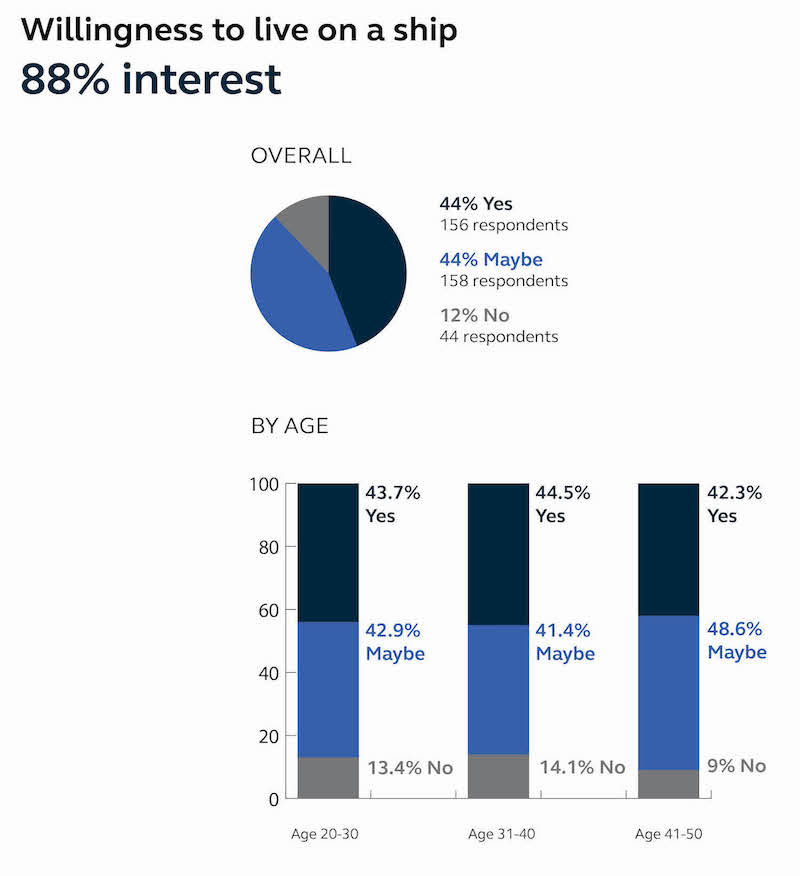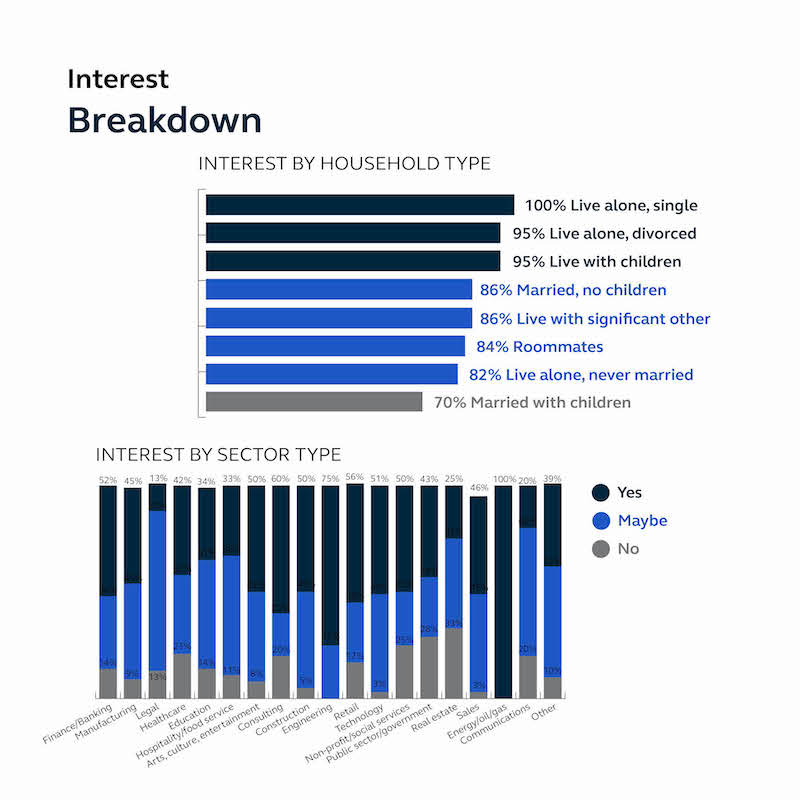In 2020, a record number of cruise ships were decommissioned, sold, or sent to a scrapyard. Due to the sudden freeze in the cruise industry, major cruise corporations reduced their fleet numbers. On top of that, the International Marine Organization changed its emission regulations and required all vessels to reduce their sulfur oxide emissions by 77 percent (IMO). This regulation mandated engines to undergo costly renovations of millions of dollars. With lower passenger capacities, this upgrade was not feasible for many ships.
The rapid increase in cruise ship decommissioning during the last 18 months has created a unique opportunity to innovate and adapt these large ships. By repurposing decommissioned cruise ships for housing in existing port areas, cruise ships could offer an alternative mode of coastal living. This housing alternative can be brought to life by utilizing the overwhelming number of decommissioned ships as a primary housing structure, using semi-permanent docking in existing port areas, and in turn, potentially creating affordable housing.
LOOKING INTO THE FUTURE
There are several ways we can explore docked residential cruise ships. As an example, ships can share ports or periodically move locations instead of having one designated port for the vessel. This idea builds on the increase of remote work that boomed in 2020 due to the COVID-19 pandemic and could attract residents who are not tied to a particular location. As many companies are transitioning to fully remote options for work, this way of living could be attractive to the digital nomad. Another possibility would be allowing residents to sign short-term leases at monthly intervals to reduce the commitment required for those traveling, migratory, or hesitant about a long-term contractual obligation.
While the idea of recycling and repurposing cruise ships may seem outlandish, these ships have the opportunity to bring more affordable housing to the masses while also keeping the ship itself alive. To test this idea, CallisonRTKL conducted an online survey of 362 adults in Miami-Dade County, (Qualtrics) to investigate perceptions from potential residents of this new living concept. The findings strongly supported the proof-of-concept, with respondents expressing (88 percent "yes" or "maybe") interest in living on a repurposed cruise ship. Those expressing the greatest interest are 41-50 years of age, earning at least $100,000 per year, who are single or single with children, and willing to pay $849 (mean) and $4,000 (max) per month.

A NEW ERA FOR DECOMMISSIONED CRUISE SHIPS
There are many considerations architects, designers, and city planners will need to take into account when creating these spaces. A permanently docked residential cruise ship requires infrastructure for fueling, waste management, power, sewer, and other provisions. Large vessel docking and crucial concrete piles necessary for docking add additional costs to the concept. A hurricane evacuation plan is also required for a residential ship and would need to be communicated to future residents before occupation. Potential hurricane damage must be accounted for when planning robust operational systems and investments.
Smaller cruise ships are more suitable for permanent docking as they require less space and dredging. Smaller ships function at a scale similar to a high-rise apartment complex, are less intrusive to the urban planning of a city, and are less likely to block views from land to sea. In terms of location, a docked residential cruise ship is most conveniently located in a body of water that is both deep and passive from wave activity, such as up-river. For example, the Hudson River, where ships are permanently moored, could serve as a great body of water for a docked residential cruise ship.
NEXT STEPS
The above statistics highlight that there is a market for transforming cruise ships into affordable housing. However, it is important to understand the cost implications behind cruise ship repurposing, including costs associated with building new pier infrastructures to be used for decommissioned cruise ships. Additionally, cost estimates must be made for city and federal planning approvals, engineering and design, and interior renovations. Beyond cost, site investigations need to take place to analyze the environmental impacts and reporting of these decommissioned cruise ships. While still in the early stages, it is an exciting idea for decommissioned cruise ships to transform into naturally occurring affordable housing, and the potential for these decommissioned ships is promising.
Related Stories
Education Facilities | Aug 4, 2024
A former supersonic wind tunnel becomes a new educational facility for transportation design
The Mullin Transportation Design Center at ArtCenter College of Design in Pasadena, Calif., provides access for full-scale vehicular models, replicating a professional design studio.
Adaptive Reuse | Jul 30, 2024
Empty mall to be converted to UCLA Research Park
UCLA recently acquired a former mall that it will convert into the UCLA Research Park that will house the California Institute for Immunology and Immunotherapy at UCLA and the UCLA Center for Quantum Science and Engineering, as well as programs across other disciplines. The 700,000-sf property, formerly the Westside Pavilion shopping mall, is two miles from the university’s main Westwood campus. Google, which previously leased part of the property, helped enable and support UCLA’s acquisition.
Great Solutions | Jul 23, 2024
41 Great Solutions for architects, engineers, and contractors
AI ChatBots, ambient computing, floating MRIs, low-carbon cement, sunshine on demand, next-generation top-down construction. These and 35 other innovations make up our 2024 Great Solutions Report, which highlights fresh ideas and innovations from leading architecture, engineering, and construction firms.
Adaptive Reuse | Jul 12, 2024
Detroit’s Michigan Central Station, centerpiece of innovation hub, opens
The recently opened Michigan Central Station in Detroit is the centerpiece of a 30-acre technology and cultural hub that will include development of urban transportation solutions. The six-year adaptive reuse project of the 640,000 sf historic station, created by the same architect as New York’s Grand Central Station, is the latest sign of a reinvigorating Detroit.
MFPRO+ News | Jun 24, 2024
‘Yes in God’s Backyard’ movement could create more affordable housing
The so-called “Yes in God’s Backyard” (YIGBY) movement, where houses of worship convert their properties to housing, could help alleviate the serious housing crisis affecting many communities around the country.
Multifamily Housing | Jun 14, 2024
AEC inspections are the key to financially viable office to residential adaptive reuse projects
About a year ago our industry was abuzz with an idea that seemed like a one-shot miracle cure for both the shockingly high rate of office vacancies and the worsening housing shortage. The seemingly simple idea of converting empty office buildings to multifamily residential seemed like an easy and elegant solution. However, in the intervening months we’ve seen only a handful of these conversions, despite near universal enthusiasm for the concept.
Adaptive Reuse | Jun 13, 2024
4 ways to transform old buildings into modern assets
As cities grow, their office inventories remain largely stagnant. Yet despite changes to the market—including the impact of hybrid work—opportunities still exist. Enter: “Midlife Metamorphosis.”
Adaptive Reuse | Jun 6, 2024
Latest phase of London redevelopment completes two new buildings
Developers are creating a neighborhood for 25,000 residents and workers.
MFPRO+ News | Jun 3, 2024
New York’s office to residential conversion program draws interest from 64 owners
New York City’s Office Conversion Accelerator Program has been contacted by the owners of 64 commercial buildings interested in converting their properties to residential use.
Adaptive Reuse | May 15, 2024
Modular adaptive reuse of parking structure grants future flexibility
The shift away from excessive parking requirements aligns with a broader movement, encouraging development of more sustainable and affordable housing.


















